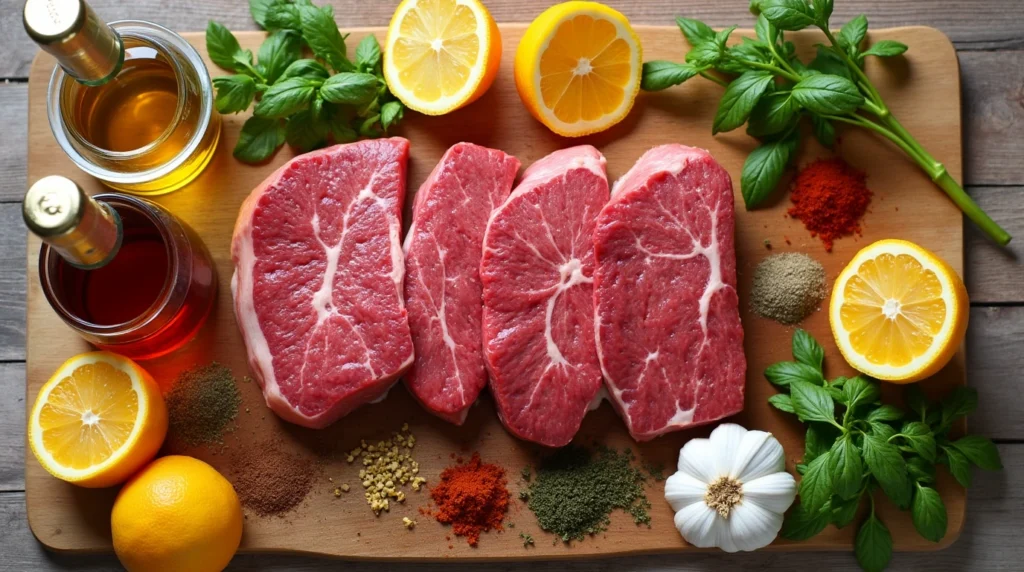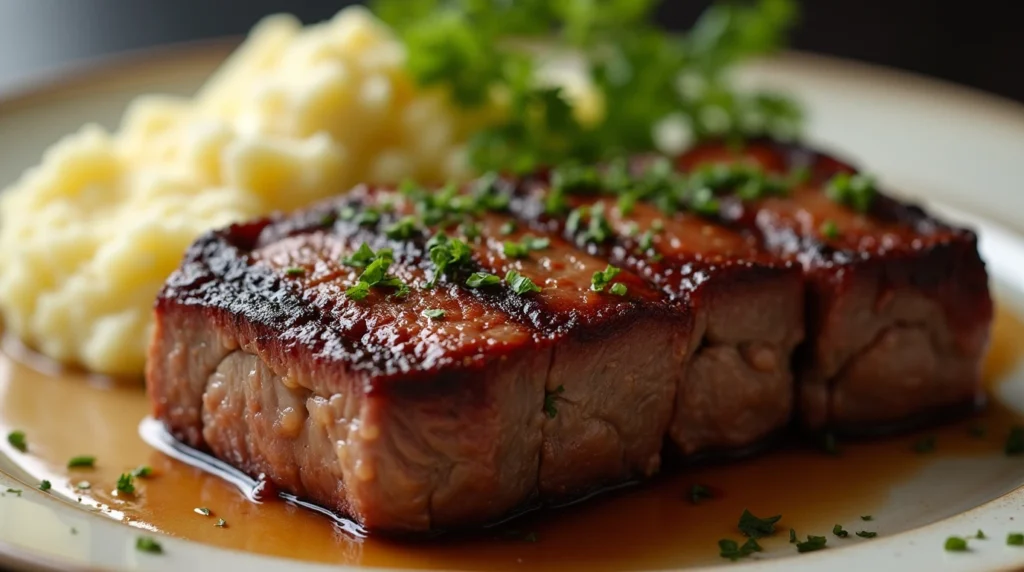When it comes to cooking meat, tenderness is often the name of the game. One cut that frequently raises questions about its texture is cube steak. Many home cooks wonder, does cube steak get more tender the longer it cooks? In this article, we’ll dive deep into the world of cube steak, exploring its characteristics, cooking methods, and the science behind tenderness. So, whether you’re a seasoned chef or a kitchen novice, you’ll find valuable insights to help you achieve the perfect cube steak.
Introduction to Cube Steak
What is Cube Steak?
Cube steak is a popular cut of beef that’s known for its unique texture and flavor. Typically, it comes from tougher cuts of meat, such as the round or chuck. The meat is mechanically tenderized, which means it’s pounded with a machine that creates small indentations, giving it that signature “cubed” appearance. This process not only helps to break down the muscle fibers but also makes it easier to cook and enjoy.
You’ll often find cube steak in comfort food recipes, like chicken-fried steak or smothered steak. It’s a versatile ingredient that can be prepared in various ways, making it a favorite among many home cooks.
Importance of Tenderness in Cooking
Tenderness is crucial when it comes to meat dishes. After all, nobody wants to bite into a tough, chewy piece of steak! Tender meat is not only more enjoyable to eat, but it also absorbs flavors better, enhancing the overall taste of your dish. Understanding how to achieve tenderness, especially with cuts like cube steak, can elevate your cooking game significantly.
Different cooking methods can affect the tenderness of meat. For instance, slow cooking can break down tough fibers, while quick methods like grilling may not yield the same results. So, it’s essential to choose the right technique to ensure your cube steak turns out tender and delicious.
Understanding Cube Steak

The Cut of Meat
To truly appreciate cube steak, it’s essential to understand where it comes from. Cube steak is typically made from tougher cuts of beef, such as the round or chuck. These cuts are known for their rich flavor but can be quite chewy if not prepared correctly. The key to transforming these tougher cuts into something tender and enjoyable lies in the tenderization process.
Unlike premium cuts like ribeye or filet mignon, cube steak is more affordable, making it a popular choice for budget-conscious cooks. Its unique texture, thanks to the mechanical tenderization, allows it to absorb marinades and seasonings beautifully, enhancing its flavor profile.
How Cube Steak is Tenderized
The tenderization process is what sets cube steak apart from other cuts. As mentioned earlier, cube steak is mechanically tenderized. This means that it’s pounded with a machine that creates small indentations in the meat. These indentations break down the muscle fibers, making the steak more tender and easier to chew.
In addition to mechanical tenderization, natural enzymes in the meat also play a role in tenderness. When meat is cooked, the heat causes these enzymes to break down collagen, a protein that can make meat tough. The longer the meat cooks, the more collagen breaks down, which can lead to a more tender result. However, there’s a fine line between achieving tenderness and overcooking, which can lead to a dry, unappetizing texture.
For information on the nutritional benefits of beef, check out this resource from the Beef Checkoff on nutritional benefits of beef.
Cooking Methods for Cube Steak
Common Cooking Techniques
When it comes to cooking cube steak, there are several methods you can choose from, each offering a unique flavor and texture. Here are some of the most popular techniques:
Pan-Frying
Pan-frying is one of the quickest and easiest ways to cook cube steak. Simply heat a bit of oil in a skillet over medium-high heat, season your steak, and cook it for a few minutes on each side. This method gives the steak a nice sear while keeping it juicy. However, be cautious not to overcook it, as this can lead to a tough texture.
Braising
Braising is a fantastic method for achieving tender cube steak. This technique involves cooking the meat slowly in a small amount of liquid, allowing it to absorb flavors while breaking down tough fibers. Start by searing the steak in a hot pan, then add broth, wine, or even a flavorful sauce, cover, and let it simmer on low heat for an extended period. The result? A melt-in-your-mouth cube steak that’s bursting with flavor.
Slow Cooking
Using a slow cooker is another excellent option for cooking cube steak. This method is perfect for busy days when you want a hearty meal waiting for you at dinner time. Simply season the steak, place it in the slow cooker with your choice of vegetables and liquid, and let it cook on low for several hours. The low and slow cooking process allows the meat to become incredibly tender, as the collagen breaks down over time.
Grilling
Grilling cube steak can be a bit tricky, as it’s easy to overcook. However, if done correctly, it can yield a deliciously charred exterior while keeping the inside juicy. To grill cube steak, preheat your grill to medium-high heat, season the meat, and cook it for a few minutes on each side. Keep a close eye on it to avoid drying it out.
Impact of Cooking Time on Tenderness
Now that we’ve covered various cooking methods, let’s talk about how cooking time affects the tenderness of cube steak. The general rule of thumb is that the longer you cook meat, the more tender it becomes. This is particularly true for tougher cuts like cube steak, where the collagen needs time to break down.
When you cook cube steak for a short period, you may end up with a chewy texture. However, if you cook it too long, you risk overcooking, which can lead to dryness. The key is to find that sweet spot where the meat is cooked through but still retains its moisture.
Does Cube Steak Get More Tender the Longer It Cooks?

The Science of Cooking Meat
To understand whether cube steak gets more tender the longer it cooks, we need to dive into the science behind meat cooking. When meat is heated, the proteins within it begin to denature, meaning they unravel and change structure. This process is crucial for tenderness, as it allows the meat to become more palatable.
One of the key components in meat that affects tenderness is collagen, a protein found in connective tissues. As cube steak cooks, the heat causes collagen to break down into gelatin, which is what gives meat its tender, juicy texture. The longer you cook the meat, the more collagen breaks down, leading to a more tender result. However, this is where things can get tricky.
To delve deeper into the science behind meat tenderness, visit Meat Science.
Optimal Cooking Times for Tenderness
So, how long should you cook cube steak to achieve that perfect tenderness? The answer varies depending on the cooking method you choose. Here are some general guidelines:
- Pan-Frying: Cook for about 3-5 minutes per side over medium-high heat. This method is quick, so be careful not to overdo it.
- Braising: For braised cube steak, aim for 1.5 to 2 hours on low heat. This slow cooking allows the collagen to break down thoroughly, resulting in a tender dish.
- Slow Cooking: In a slow cooker, cook cube steak on low for 6-8 hours. This extended cooking time is perfect for breaking down tough fibers and achieving maximum tenderness.
- Grilling: Grill for about 4-6 minutes per side, but keep a close eye on it to prevent overcooking.
Signs That Cube Steak is Tender
Knowing when your cube steak is tender can be a bit of an art. Here are some signs to look for:
- Visual Cues: The meat should appear juicy and have a slight sheen. If it looks dry or overly browned, it may be overcooked.
- Texture: When you cut into the steak, it should feel soft and yield easily to your knife. If it’s tough or chewy, it likely needs more cooking time or a different method.
- Internal Temperature: For cube steak, aim for an internal temperature of around 145°F (63°C) for medium-rare. Remember, the meat will continue to cook slightly after you remove it from the heat, so consider that when checking for doneness.
Overcooking: The Downside
While it’s true that cooking cube steak longer can lead to tenderness, there’s a fine line between tender and tough. Overcooking can dry out the meat, making it less enjoyable to eat. The key is to monitor your cooking time closely and use methods that allow for gradual cooking, like braising or slow cooking.
Tips for Cooking Tender Cube Steak
Marinating for Tenderness
One of the best ways to enhance the tenderness of cube steak is through marinating. A good marinade not only adds flavor but also helps to break down tough fibers in the meat. Here are some tips for creating an effective marinade:
- Acidic Ingredients: Incorporate acidic components like vinegar, citrus juice, or yogurt. These ingredients help to tenderize the meat by breaking down proteins. For example, a marinade with lemon juice or balsamic vinegar can work wonders.
- Flavorful Additions: Don’t forget to add herbs, spices, and aromatics to your marinade. Garlic, onion, rosemary, and thyme can infuse the meat with delicious flavors while also aiding in tenderness.
- Marinating Time: Allow the cube steak to marinate for at least 30 minutes, but for optimal results, aim for 2-4 hours. If you have the time, marinating overnight can yield even better results.
Cooking Temperature and Techniques
The cooking temperature you choose can significantly impact the tenderness of your cube steak. Here are some recommendations:
- Low and Slow: As mentioned earlier, cooking cube steak at a low temperature for an extended period is key to achieving tenderness. Whether you’re braising or using a slow cooker, keeping the heat low allows the collagen to break down gradually.
- Searing First: If you’re pan-frying or grilling, consider searing the steak first. This technique involves cooking the meat at a high temperature for a short time to create a flavorful crust. After searing, you can finish cooking it at a lower temperature to ensure it remains tender.
- Resting Time: After cooking, let your cube steak rest for a few minutes before slicing. This allows the juices to redistribute throughout the meat, resulting in a juicier and more tender steak.
Additional Tips for Tender Cube Steak
- Use a Meat Mallet: If you want to take the tenderization process a step further, consider using a meat mallet. Gently pound the steak before cooking to break down fibers even more.
- Avoid Overcrowding the Pan: When pan-frying, avoid overcrowding the skillet. Cooking in batches allows for even cooking and prevents steaming, which can lead to a tougher texture.
- Monitor Cooking Time: Keep a close eye on your cooking time. Remember, cube steak cooks quickly, and overcooking can lead to dryness. Use a meat thermometer to check for doneness.
Conclusion
Summary of Key Points
Throughout this article, we’ve explored the fascinating world of cube steak, focusing on its unique characteristics and the best methods for cooking it to achieve tenderness. We learned that cube steak is a cut of meat that comes from tougher parts of the cow, such as the round or chuck, and is mechanically tenderized to enhance its texture.
We discussed various cooking techniques, including pan-frying, braising, slow cooking, and grilling, each offering different benefits for achieving that sought-after tenderness. The science behind cooking meat revealed that collagen breakdown is crucial for tenderness, and we highlighted optimal cooking times for each method to ensure your cube steak turns out perfectly.
Additionally, we provided tips for marinating, cooking temperatures, and techniques to further enhance the tenderness of your cube steak. Remember, while longer cooking times can lead to tenderness, overcooking can result in dryness, so it’s essential to find that balance.
Final Thoughts on Cooking Cube Steak
In conclusion, cooking cube steak can be a rewarding experience when you understand the nuances of this versatile cut. With the right techniques and a little patience, you can transform a tough piece of meat into a tender, flavorful dish that your family and friends will love. So, whether you’re pan-frying for a quick weeknight dinner or slow cooking for a comforting meal, don’t hesitate to experiment with cube steak in your kitchen.
FAQs
Can You Overcook Cube Steak?
Absolutely! While cooking cube steak longer can lead to tenderness, overcooking can have the opposite effect. If you leave it on the heat for too long, the meat can become dry and tough. It’s essential to monitor your cooking time closely and use methods that allow for gradual cooking, like braising or slow cooking, to avoid this pitfall.
What is the Best Way to Cook Cube Steak?
The best way to cook cube steak largely depends on your personal preference and the time you have available. For quick meals, pan-frying is a great option. However, if you’re looking for maximum tenderness, braising or slow cooking is the way to go. These methods allow the meat to absorb flavors and break down tough fibers, resulting in a deliciously tender dish.
How Do You Know When Cube Steak is Done?
To determine if your cube steak is done, you can use a meat thermometer. Aim for an internal temperature of around 145°F (63°C) for medium-rare. Additionally, look for visual cues: the meat should appear juicy and have a slight sheen. When you cut into it, the texture should feel soft and yield easily to your knife. If it’s tough or chewy, it likely needs more cooking time.
Is Cube Steak Tough or Tender?
Cube steak is generally considered a tougher cut of meat due to its origins from the round or chuck. However, the mechanical tenderization process and proper cooking techniques can transform it into a tender and flavorful dish. With the right methods, you can enjoy a deliciously tender cube steak that rivals more expensive cuts.
Can You Use Cube Steak in Slow Cookers?
Yes, cube steak is an excellent choice for slow cooking! In fact, using a slow cooker is one of the best ways to achieve maximum tenderness. Simply season the steak, add your choice of vegetables and liquid, and let it cook on low for several hours. The slow cooking process allows the collagen to break down, resulting in a melt-in-your-mouth texture.
Now that you’re armed with knowledge and tips, it’s time to get cooking! Enjoy the process, and savor the delicious results of your culinary efforts. Happy cooking!
